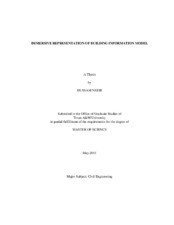| dc.description.abstract | Building Information Modeling (BIM) is an emerging technology that utilizes 3D graphical representations to improve communication, collaboration, and data exchange. Immersive Visualization Environment (IVE) is another promising technology that enhances the 3D graphical representation to achieve a higher level of a sense of presence. The connection between the BIM technology that utilizes the 3D graphical representation and the IVE technology that enhances the 3D graphical representation has led many professionals to visualize BIM in immersive environments. This study is an attempt to overcome a systematic issue presented by available immersive visualization systems. The problem is that in order to visualize an information-rich BIM model from a commercial BIM application in an immersive visualization environment, the BIM model needs to pass through a tough conversion process and loss a large amount of its information. This research study utilizes the Application Programming Interface (API) of a commercially available BIM application to develop an immersive visualization environment. This approach was applied on Autodesk Navisworks software by developing a software program that utilizes Navisworks' API to control Navisworks' camera angle and generate an immersive visualization environment. A prototype of the approach was built in the Department of Construction Science at Texas A & M University and named BIM CAVE Prototype.
The overall goal of this research was to prove that it is possible to transform a commercial BIM application into an immersive visualization system. A phenomenological study was utilized by interviewing subject matter experts from the construction industry. The intent of this effort was to explore and develop a phenomenological understanding of how research participants perceived the BIM CAVE system. The results show that the BIM CAVE can be considered an immersive visualization environment because it contains a majority of the immersive visualization environment features. However, a variety of technical limitations must be overcome before it can be called a fully immersive and functional visualization environment. Moreover, even though this investigation was to some extent successful, this research approach needs to be tested on other commercially available BIM applications before generalizations are made. | en |


